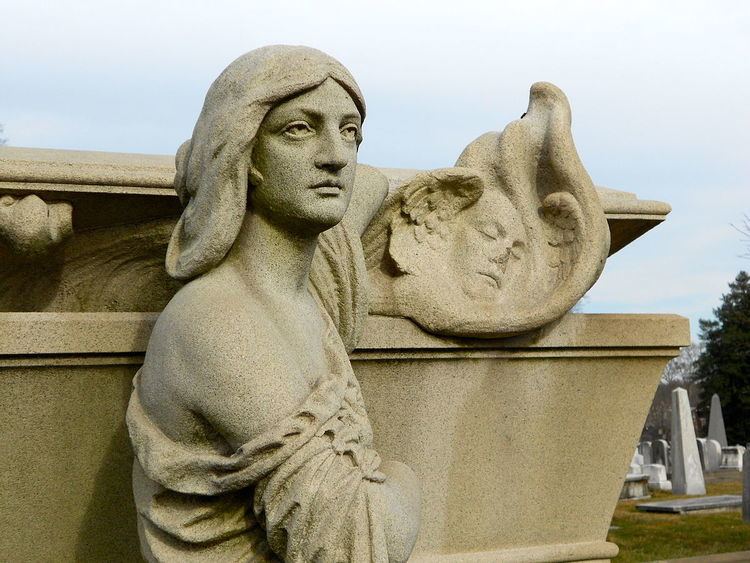Built 1836-1839 NRHP Reference # 77001185 Area 33 ha Added to NRHP 28 October 1977 | Designated PHMC May 20, 2000 Phone +1 215-228-8200 | |
 | ||
Architectural style Exotic Revival, Gothic, Classical Revival Address 3822 Ridge Ave, Philadelphia, PA 19132, USA Hours Open today · 8:30AM–4:30PMMonday8:30AM–4:30PMTuesday8:30AM–4:30PMWednesday8:30AM–4:30PMThursday8:30AM–4:30PMFriday8:30AM–4:30PMSaturday9:30AM–4:30PMSunday9:30AM–4:30PM Burials George Meade, Elisha Kane, Frank Furness Similar The Woodlands, Eastern State Penitentiary, Schuylkill River, Mount Moriah Cemetery, Boat House Row Profiles | ||
Laurel hill cemetery philadelphia pennsylvania
Laurel Hill Cemetery is a cemetery in Philadelphia, Pennsylvania, that was the second major garden or rural cemetery in the United States. It was designated a National Historic Landmark in 1998, one of only a few cemeteries to receive the distinction.
Contents
- Laurel hill cemetery philadelphia pennsylvania
- A walk through west laurel hill cemetery bala cynwyd pa
- History
- Notable burials
- References
Located in Philadelphia's East Falls section, the 74-acre (300,000 m2) cemetery overlooks the Schuylkill River. Laurel Hill contains more than 33,000 monuments and more than 11,000 family lots. Its thousands of 19th- and 20th-century marble and granite funerary monuments include obelisks and elaborately sculpted hillside tombs and mausoleums.
A walk through west laurel hill cemetery bala cynwyd pa
History
The cemetery was founded in 1836 by John Jay Smith, a librarian and editor with interests in horticulture and real estate who was distressed at the way his deceased daughter was interred in a Philadelphia churchyard. He and other prominent citizens decided to create a rural garden cemetery five miles north of Philadelphia, a location that was viewed as a haven from urban expansion and a respite from the increasingly industrialized city center. The property was acquired from businessman Joseph Sims.
Designed by Scottish-American architect John Notman, Laurel Hill introduced new landscape ideas and burial concepts and became a model for the rural cemetery movement. The cemetery was developed and completed between 1836 and 1839. To increase its cachet, the cemetery's organizers had the remains of several famous Revolutionary War figures moved there, including Continental Congress secretary Charles Thomson; Declaration of Independence signer Thomas McKean; Philadelphia war veteran and shipbuilder Jehu Eyre; Hugh Mercer, hero of the Battle of Princeton; and David Rittenhouse, first director of the U.S. Mint.
During and after the American Civil War, Laurel Hill became the final resting place of hundreds of military figures, including 42 Civil War-era generals. Laurel Hill also became the favored burial place for many of Philadelphia's most prominent political and business figures, including Matthias W. Baldwin, founder of the Baldwin Locomotive Works; Henry Disston, owner of the largest saw factory in the world (the Disston Saw Works); and financier Peter A. B. Widener.
The city later grew past Laurel Hill, but the cemetery retained its rural character.
From its inception, Laurel Hill was intended as a civic institution designed for public use. In an era before public parks and museums, it was a multi-purpose cultural attraction where the general public could experience the art and refinement previously known only to the wealthy. Classical Revival, Gothic Revival, Egyptian Revival and other exotic styles are rendered in a wide palette of materials, including marble, granite, cast-iron and sandstone. Notable artists and architects, including Notman, Alexander Milne Calder and William Strickland contributed their designs. Laurel Hill became an immensely popular destination in its early years and required tickets for admission. Writer Andrew Jackson Downing reported “nearly 30,000 persons…entered the gates between April and December, 1848.”
In 1978, the Friends of Laurel Hill Cemetery, a 501(c)(3) non-profit organization, was founded to support the cemetery. The mission of the Friends is to assist the Laurel Hill Cemetery Company in preserving and promoting the historical character of Laurel Hill. The Friends raise funds and seek contributed services; prepare educational and research materials emphasizing the historical, architectural and cultural importance of Laurel Hill Cemetery; and provide tour guides to educate the public.
In the 21st century, two pairs of seats from Veterans Stadium were installed at the grave of Harry Kalas, the Frick Award-winning announcer for the Philadelphia Phillies, so they could be used by fans paying their respects.
Today, Laurel Hill Cemetery stands as a rich repository of both art and historical artifacts. Its monuments embody the rich design, craftsmanship and iconography of 19th and 20th century American funerary art, from simple obelisks to elaborate mausoleums.
Notable burials
Burials in the cemetery include:
